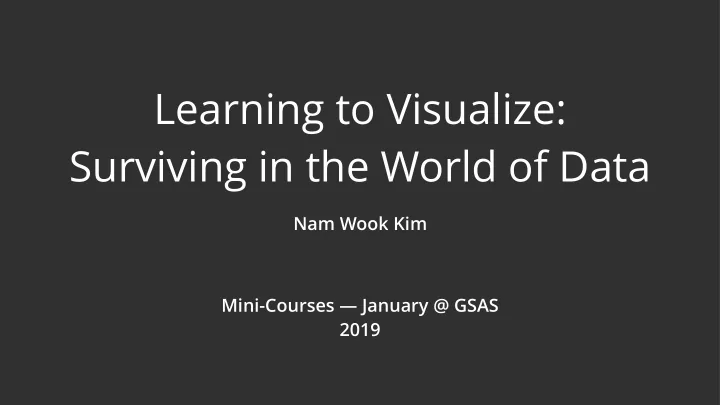

Learning to Visualize: Surviving in the World of Data Nam Wook Kim Mini-Courses — January @ GSAS 2019
About Me
Nam Wook Kim 5th-Year Ph.D. Student Computer Science Department Information Visualization & Human-Computer Interaction
About You
Goal To learn how to design e ff ective visualization
Goal To learn how to evaluate visualization design
Today Fundamental 1. Value of visualization 2. Design principles 3. Graphical perception
Tomorrow Practical 1. Data model and visual encoding 2. Exploratory data analysis 3. Storytelling with data 4. Advanced visualizations
Tomorrow Practical 1. Data model and visual encoding Tableau { 2. Exploratory data analysis 3. Storytelling with data 4. Advanced visualizations
The Value of Visualization
Big Data Small Data Data Everywhere
Replace with a visualization example. Event sequence analysis?? Medical visualization (scientific) Health & Medicine
Transportation https://eng.uber.com/data-viz-intel/
http://atlas.cid.harvard.edu/ Economy
https://www.trulia.com/real_estate/Cambridge-Massachusetts/crime/ Public Safety
Human Activity
The Industrial Revolution of Data Joe Hellerstein, UC Berkley, 2008
Data Literacy “The ability to take data — to be able to understand it, to process it, to extract value from it, to visualize it, to communicate it — that’s going to be a hugely important skill in the next decades …’’ Hal Varian, Google’s Chief Economist The McKinsey Quarterly, January 2009
A Poverty of Attention “…Information consumes the attention of its recipients. Hence … a need to allocate that attention e ffi ciently among the overabundance of information sources that might consume it.” Herbert A. Simon Economist & Psychologist
Visualization can help! provides a powerful yet accessible way to Collage of visualizations make sense of large and complex data
What is Visualization?
“Transformation of the symbolic into the geometric ” —McCormick et al. 1987 “... finding the artificial memory that best supports our natural means of perception.” —Bertin 1967 “visual representations of data to amplify cognition .” —Card, Mackinlay, & Shneiderman 1999
...to convey information through graphical representations
Anscombe’s Quartet A B C D X Y X Y X Y X Y 10.0 8.04 10.0 9.14 10.0 7.46 8.0 6.58 8.0 6.95 8.0 8.14 8.0 6.77 8.0 5.76 13.0 7.58 13.0 8.74 13.0 12.74 8.0 7.71 Summary Statistics 9.0 8.81 9.0 8.77 9.0 7.11 8.0 8.84 u X = 9.0 σ X = 3.317 11.0 8.33 11.0 9.26 11.0 7.81 8.0 8.47 u Y = 7.5 σ Y = 2.03 14.0 9.96 14.0 8.10 14.0 8.84 8.0 7.04 6.0 7.24 6.0 6.13 6.0 6.08 8.0 5.25 4.0 4.26 4.0 3.10 4.0 5.39 19.0 12.50 Linear Regression 12.0 10.84 12.0 9.13 12.0 8.15 8.0 5.56 Y = 3 + 0.5 X 7.0 4.82 7.0 7.26 7.0 6.42 8.0 7.91 R 2 = 0.67 5.0 5.68 5.0 4.74 5.0 5.73 8.0 6.8
A B 15 15 11 11 8 8 Y Y 4 4 0 0 0 4 8 11 15 0 4 8 11 15 X X C D 15 15 11 11 8 8 Y Y 4 4 0 0 0 4 8 11 15 0 5 10 15 20 X X
“ ...make both calculations and graphs. Both sorts of output should be studied; each will contribute to understanding. F. J. Anscombe, 1973
All distinct datasets with same statistical properties Matejka & Fitzmaurice 2017
Why Create Visualizations?
Why Create Visualizations? • Answer questions (or discover them) • Make decisions • See data in context • Expand memory • Support graphical calculation • Find patterns • Present argument or tell a story • Inspire
Three functions of visualization 1. Record 2. Analyze 3. Communicate
Record Information
6200 BC
Leonardo da Vinci 1485
Galileo Galilei's Sketches of the Moon (November-December 1609)
E. J. Muybridge, 1878
Support Reasoning
Analyze John Snow, the Cholera Epidemic 1854
Seeing Data in Context Analyze Plotted the position of each cholera case on a map. [from Tufte 83]
The Broad Street Well Used map to hypothesize that pump on Broad St. was the cause. [from Tufte 83]
Space Shuttle Challenger Disaster (1986) approx. 73 seconds after
Rubber O-rings had problems with cold temperatures.
One of original reports sent to NASA officials before launch
Use a right visualization to make a right decision [Edward Tufte 1997]
Expand Memory: Feynman Diagram (1948) "since the middle of the 20th century, theoretical physicists have increasingly turned to this tool to help them undertake critical calculations” — David Kaiser
Now: Exploratory analysis in modern visualization software Tableau
Convey Information to Others
Death from wounds in battle Death from other causes Death from disease “to affect thro’ the Eyes what we fail to convey to the public through their word-proof ears” - Nightingale Nightingale’s Coxcomb of Crimean War Deaths 1867
Napoleon’s March to Moscow [Charles Joseph Minard 1812] 422,000 10,000 survived Temperature drops during the retreat
[Joseph Priestley 1765]
William Playfair 1786
William Playfair 1821
Now: Storytelling with data: Infographics, dashboards, etc.
The Value of Visualization Record information Blueprints, photographs, seismographs, … Analyze data to support reasoning Develop and assess hypotheses Explore patterns and discover the unknown Expand memory Communicate information to others Explain and persuade Share and inspire
Goals of Visualization Research Understand how people perceive/comprehend visualizations Develop principles and techniques for e ff ective visualizations
Next Is this good, bad or weird? Data Visualization: The Good, the Bad, the Weird
5 min break
Recommend
More recommend